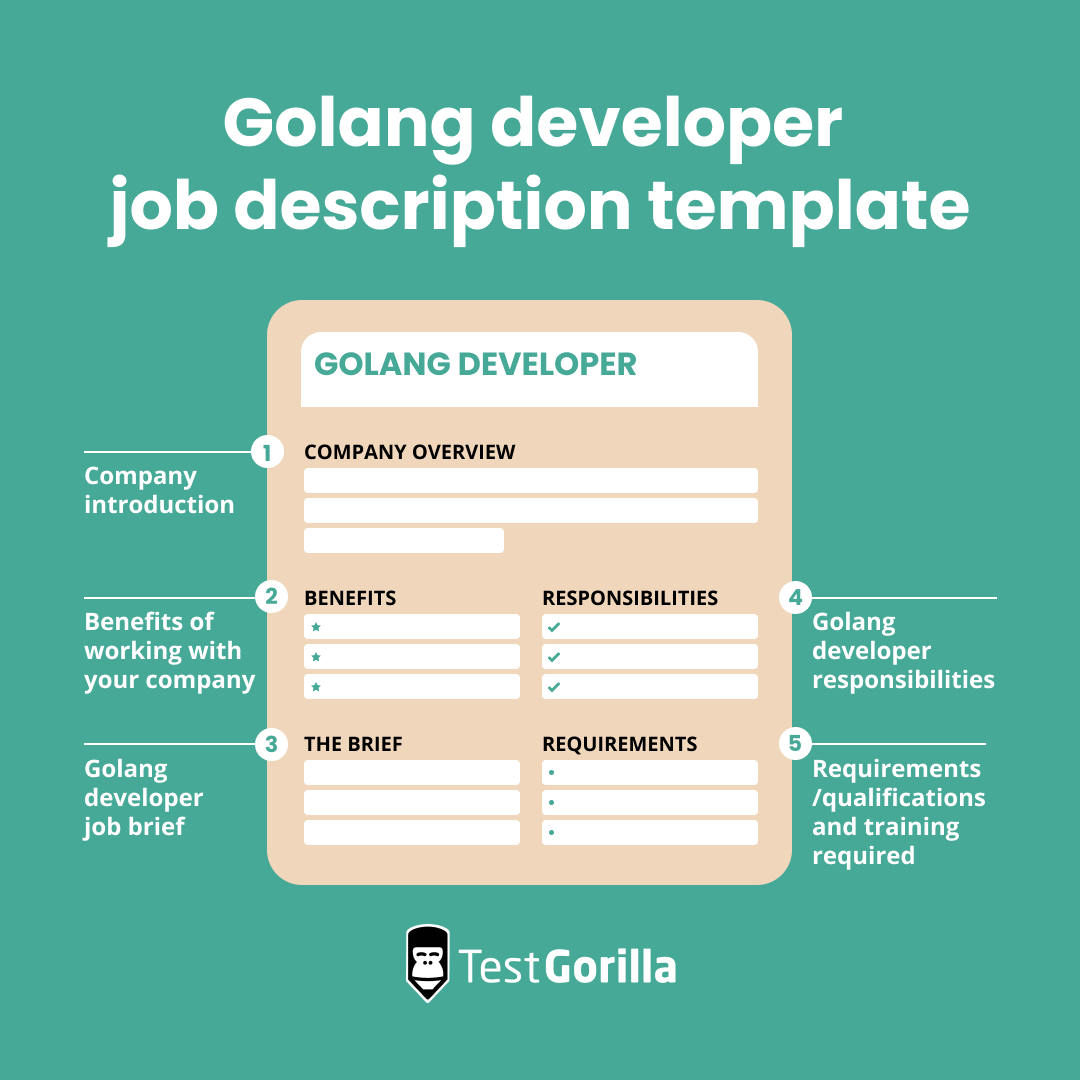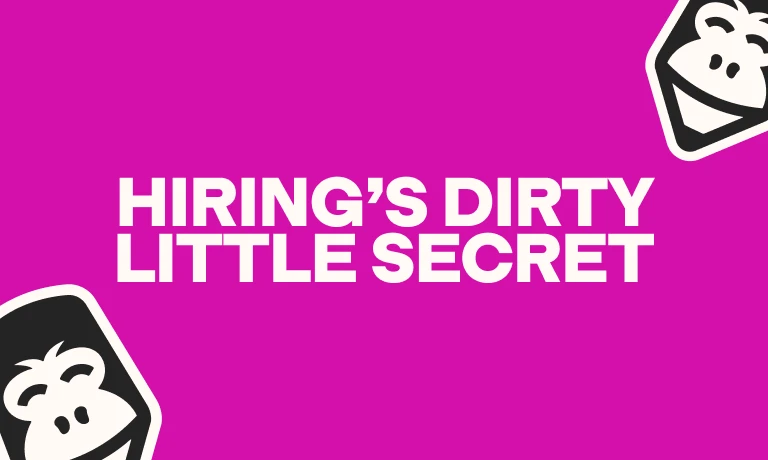Golang is a versatile, cross-platform programming language suitable for various tasks, including web development, backend systems, and mobile apps. Golang proficiency is in high demand, so finding a qualified developer can be challenging.
A great Golang developer job description can help you attract the best candidates. But writing a persuasive and descriptive job description can be tricky – especially when you’re hiring for such a technical and specialized role.
We’ve got you covered. In this article, we explain exactly how to write one – plus, we detail the skills to highlight and the pitfalls to avoid. We also included a Golang developer job description template you can use to begin.
Table of contents
- What is a Golang developer?
- Key skills to look for in Golang developers
- How to write an effective Golang developer job description
- Golang developer job description template
- 3 things to avoid when writing a job description for Golang developers
- Next steps: Attracting and assessing Golang developer candidates
- FAQs
- Make hiring your Golang Developer easier with TestGorilla
What is a Golang developer?
Golang (also known as Go) is an open-source programming language used for building web applications, networking and cloud services, and software.
Golang developers are responsible for tasks like writing and documenting code, designing and architecting applications, contributing to open-source projects, and optimizing security. Their specific responsibilities vary based on their organization's needs and project scope.
Key skills to look for in Golang developers
A strong Golang developer has the right combination of technical skills and soft skills. Include a mix of both in your job description. Look for someone with the following qualities:
Strong Go knowledge, including understanding of syntax, idioms, and best practices
Familiarity with concurrency in Go, using goroutines and channels for effective concurrent and parallel processing
Performance optimization for increasing efficiency and minimizing memory usage of applications
Web development, including building web services and RESTful APIs, and experience with web frameworks like Gin or Echo
Critical thinking for debugging and resolving complex coding issues
Collaboration skills for working effectively in a team and communicating ideas clearly
The best insights on HR and recruitment, delivered to your inbox.
Biweekly updates. No spam. Unsubscribe any time.
How to write an effective Golang developer job description
A great job description should give job seekers an accurate representation of the job and persuade them to apply. Here’s how you can do that.
Determine your ideal candidate
Before you begin writing your job description, clarify the scope of your project and the ideal candidate who can best fill your role. For example, maybe you're working on a real-time analytics platform and seeking a Golang developer with a strong understanding of distributed systems and real-time data processing.
Involve other team members who will work with the developer. They can provide insight into the skills and personality the ideal candidate should have to be successful on the team.
Describe daily tasks
In your job description, you can give a brief overview of the projects (or projects) your developer might work on and the long-term goals of the project. Include specific examples and describe the day-to-day responsibilities of the role – such as participating in daily stand-up meetings with the development team and optimizing existing codebases for performance and scalability.
Persuade candidates to work for you
To interest high-quality Golang developers in your company, use your job description like an advertisement. Make it attractive by highlighting your company’s culture and showcasing the perks of working there, like:
Flexible working hours
Remote working options
Competitive compensation
Opportunities to contribute to open-source projects
Challenging and interesting projects
Golang developer job description template
Below is a template you can use to prepare your job description. Be sure to add or change details as necessary.
Company introduction
In this section, give candidates a brief introduction to your company. Describe what your company does, which project(s) you need a Golang developer’s help with, and how they’ll contribute to your team.
Benefits of working with [your company]
Including a benefits section is a great way to attract more applicants. Don’t just include standard benefits like health insurance and 401k contributions. Detail all the benefits that come with the position – like paid time off and professional development opportunities.
Golang developer job brief
[Company name]
Job Title: [For example, Golang Developer, Senior Golang Developer, or Junior Golang Developer]
Reports to: [Head of Development, Project Manager, or Development Team Lead]
Position type: [For example, full-time, contract, on-site, remote, or hybrid]
[Compensation details]
Golang developer responsibilities
Developing, testing, and maintaining code using Go
Designing and architecting applications
Implementing concurrency using goroutines and channels to manage parallel tasks efficiently
Writing unit tests and debugging code to ensure reliability and quality of the software
Collaborating with [team members] and participating in code reviews and discussions to ensure the project’s success
Staying updated with the latest industry and tech trends in Golang development
Requirements/Qualifications
Bachelor's degree in software engineering, computer science, or a related field (or equivalent training)
Expertise in the Go programming language, including knowledge of syntax, standard library, and best practices
[Number+] years’ professional experience in Golang development
Strong understanding of concurrent and parallel programming using goroutines and channels
Experience in web development using Golang, including building web services, RESTful APIs, and web applications
3 things to avoid when writing a job description for Golang developers
Avoid these common pitfalls to make your job description as attractive as possible and broaden your applicant pool.
1. Exclusionary language
Avoid exclusionary language in your job description to attract diverse applicants, adhere to employment laws, and practice fair hiring. You might not realize it, but common words and phrases can create bias.
For example, gender-charged language like “go-getter” or “aggressive” can discourage female applicants from applying. Words like “young” and “energetic” can exclude older candidates.
2. No remote options
Golang developers are in high demand. By opening your job up to remote candidates, you can give yourself a much larger talent pool to choose from. Jobs with remote or hybrid options are also more enticing to developers.
3. Degree requirements
Though degrees in fields like computer science and software engineering can be helpful for a Golang developer, candidates can get the training and experience they need to be successful through other means.
Let candidates know in your job description if you’re willing to accept self-learning and coding boot camps in place of degrees. By emphasizing skills and knowledge over formal education, you’ll broaden your candidate pool and potentially attract highly motivated diverse talent.
Next steps: Attracting and assessing Golang developer candidates
After creating a thorough job description, make it visible. Use specialized job boards, tech community forums, and social media platforms known for tech talent to increase your job posting's reach to Golang professionals.
Once you have a pool of applicants, pre-employment assessments can help you determine which of them have the skills you need.
For example, TestGorilla’s universal coding tests include a variety of skills assessments you might use, including:
We also have a range of other tests for Golang developers. Alongside hard skills assessments (including assessments for CSS and HTML5), there are tests for soft skills like critical thinking and culture add.
By assessing both hard and soft skills, you can find someone who’s not only capable but also meshes well with your team and organization. This way, you’ll avoid making a mis-hire – which could slow down your development project, cause discord amongst your team, or worse.
FAQs
How many years’ experience should I require for junior versus senior roles?
For junior roles, consider requiring 1-2 years’ experience. For senior roles, you might want candidates with five or more years’ experience.
What salary should I offer in my job description?
In the US, a Golang developer’s average annual salary is around $168,000, but pay is often dependent on experience and location. To determine a competitive salary that attracts top candidates, you can use resources like Glassdoor’s salary calculator, which includes location-specific information. Your salary should be similar to or better than the average to be “competitive.” If possible, indicate a flexible salary range that shows you're willing to negotiate based on the candidate’s unique qualifications and location.
Make hiring your Golang Developer easier with TestGorilla
Go is a versatile and popular programming language, and hiring an in-demand Golang developer can be difficult. A thorough job description can attract more talent to your open role and give you more applicants to choose from.
An effective job description gives candidates detailed information about the role and your company – including the role’s responsibilities and the hard and soft skills required for the position.
Once you’ve got a strong applicant pool, you can assess their skills with pre-employment assessments from TestGorilla. Sign up for a free TestGorilla account today to learn how we can help you hire your next Golang developer.
You've scrolled this far
Why not try TestGorilla for free, and see what happens when you put skills first.




















